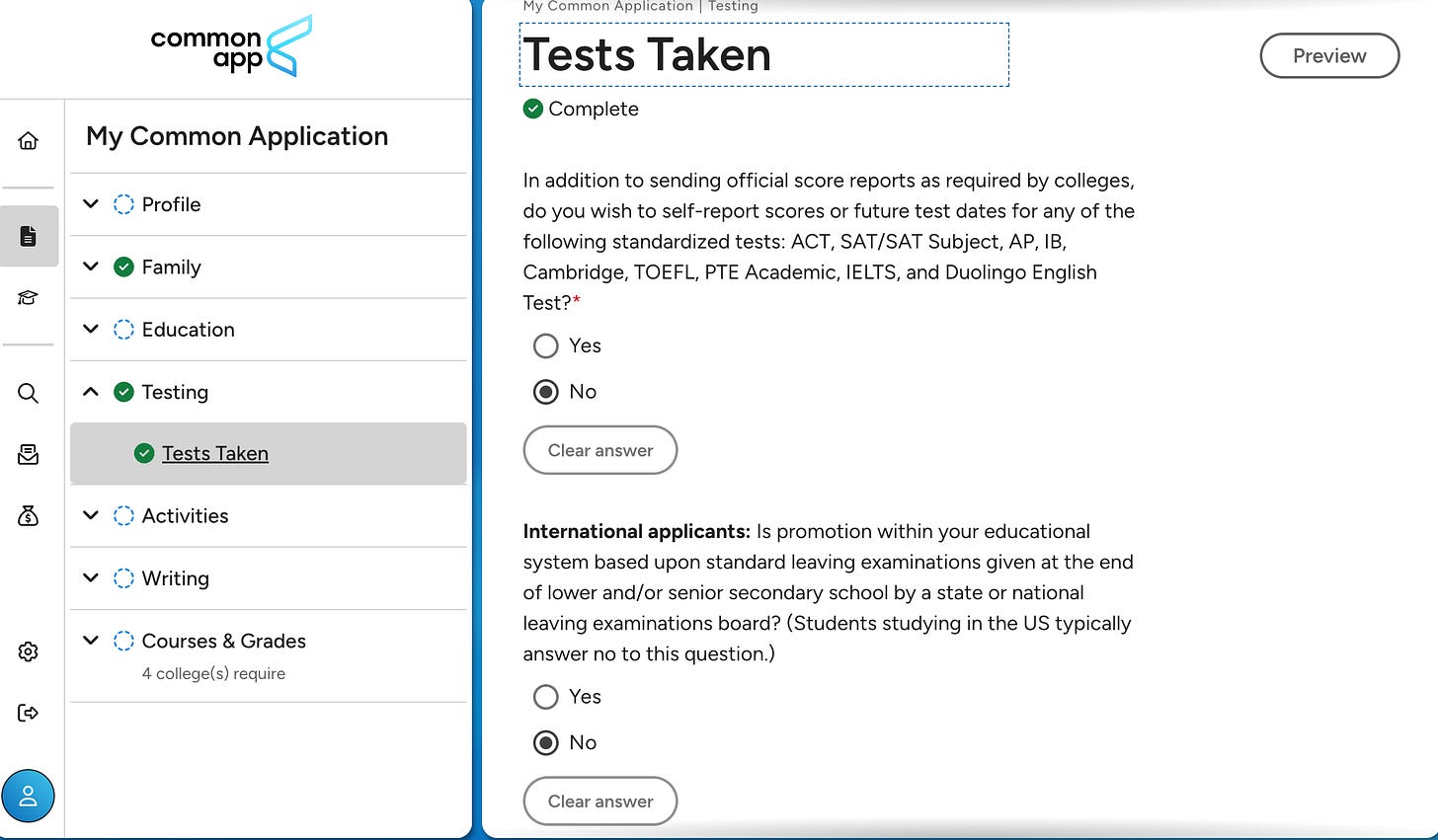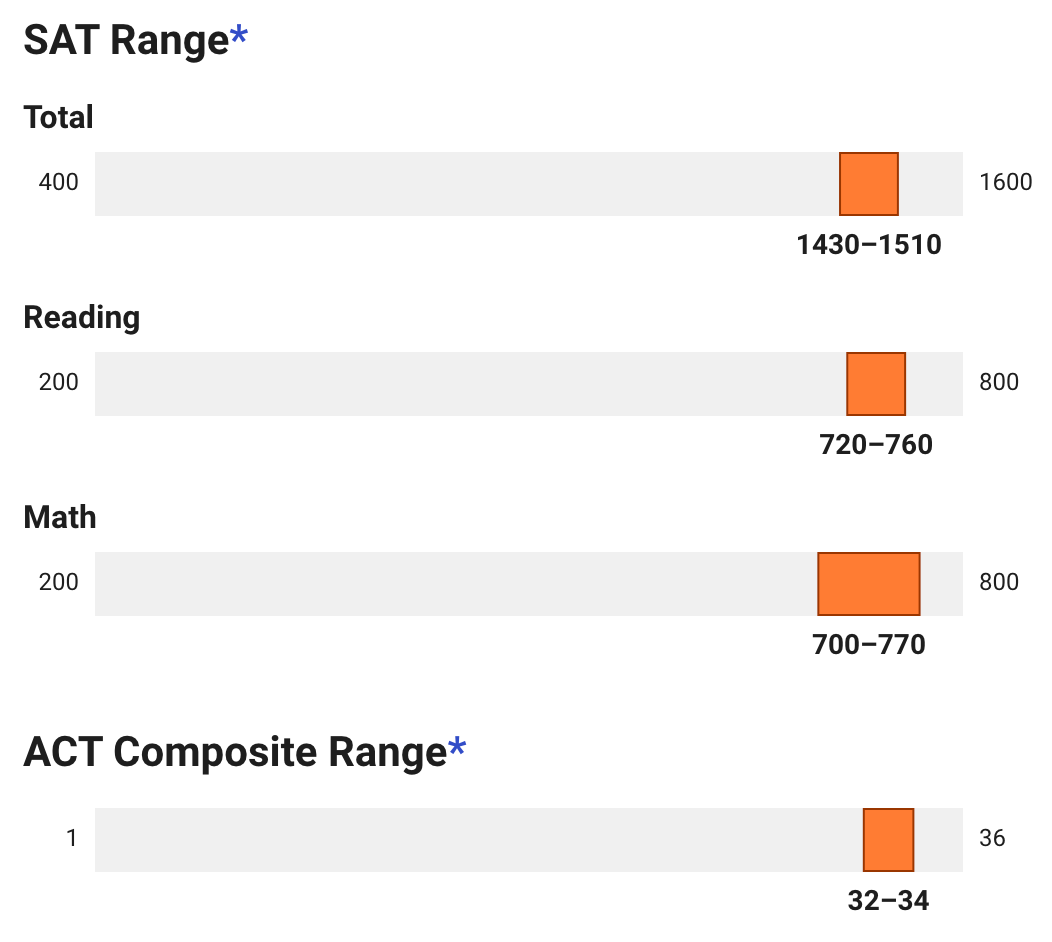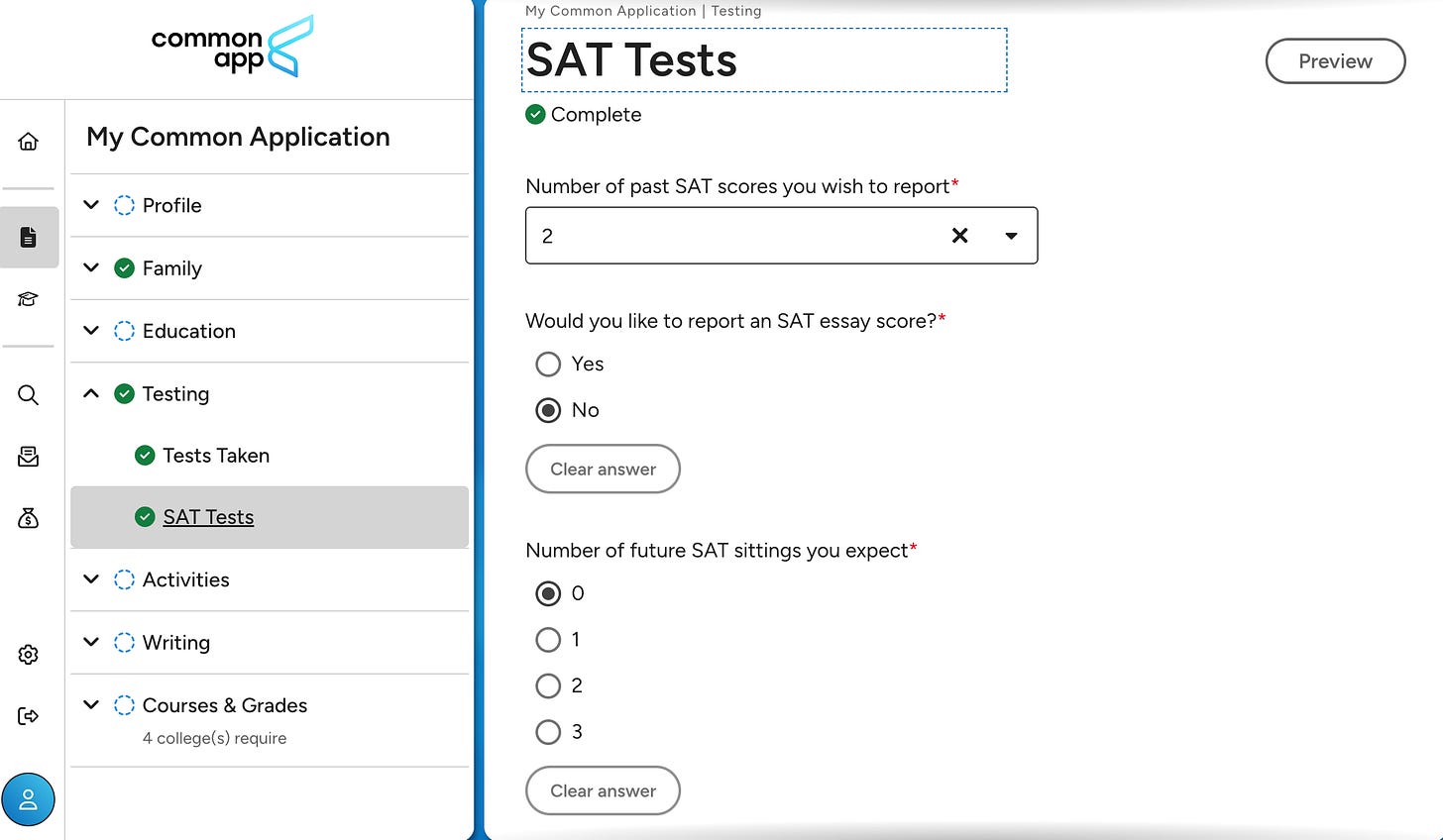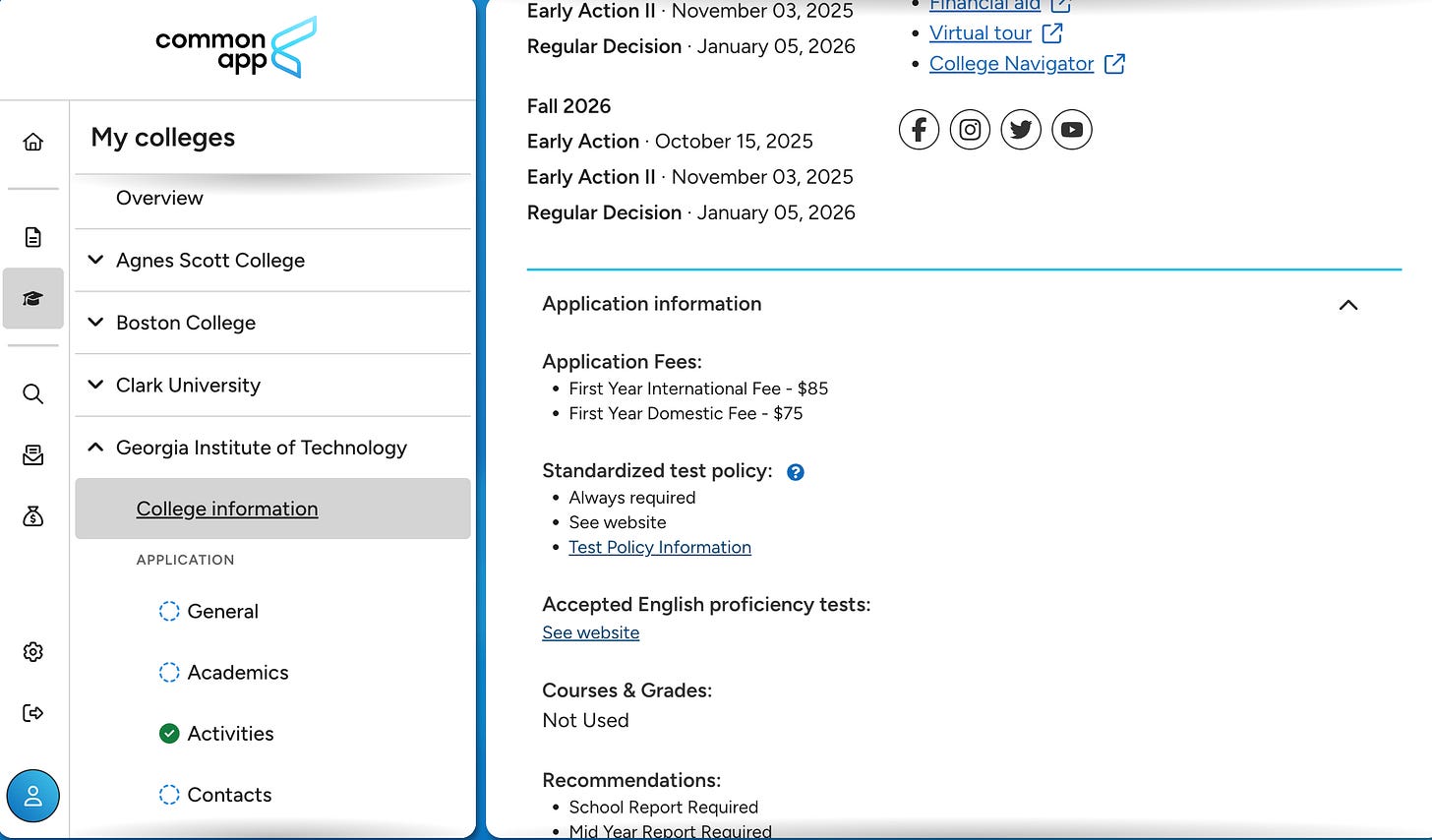Common App Section by Section - Testing
Navigate the Testing section of the Common App and decide which scores to include.
Testing
In this section of the Common App you’ll be asked to optionally provide information about standardised test scores such as the SAT and ACT. There’s also space to provide testing information for AP, IB, Cambridge, TOEFL, PTE Academics, ILTS, and Duolingo English Tests.
You probably haven’t heard of many of these tests… don’t worry - most are relevant only to international students, meaning students who attend high school outside of the USA.
TBH, I personally find this ‘Testing’ section of the app confusing so let me try to simplify by providing you three pathways:
Path 1. You do NOT want to self-report scores. [most students should choose this path]
Path 2. You want to self-report scores, and send them to all colleges.
Path 3. You want to self-report scores, but send them only to some colleges.
PATH 1 - You do NOT want to self-report scores
Here’s the truth - you don’t actually have to complete the ‘Testing’ section of the Common App (that’s why both of the high-level questions in this section are optional, not required).
In fact, I would say that the majority of students should end up leaving this ‘Testing’ section blank. And that’s perfectly OK.
Here are some reasons you might want to skip this section:
You are not applying to any schools that require you to submit test scores.
Test required schools make you submit tests. You don’t really have a choice, other than choosing to apply to different schools. Thankfully, only about 4% of all colleges and universities require standardised tests. The remaining 96% are test optional or test blind.
Test optional schools allow students to choose whether or not to submit test scores. Students who choose not to submit scores are not penalised - that data point just isn’t used at all as part of evaluating the application.
Test blind (also sometimes called test free) schools do not consider standardised test scores as a part of admissions for any student.
So, unless you are applying to one of the 4% of colleges and universities that require standardised tests, you don’t have to complete the ‘testing’ section.
Your test scores don’t enhance your application.
You want to include scores that give your app a boost, and exclude reporting scores that don’t.
This is more difficult to achieve than you may think.
About a decade back, when most colleges still required SAT/ACT tests, the admitted student profile - that’s admissions speak for the data about the students who were accepted - tended to reflect a range of standardised test scores. Some admitted students did really well on the SAT/ACT, others didn’t. (Of course the range skewed higher at schools with more competitive admissions.)
Nowadays, reported test scores skew higher almost everywhere. With test optional admissions, students who don’t score as well on the SAT/ACT simply choose not to submit their score, as including would detract from their application. What this means is that a minority of students choose to report their SAT/ACT score, and when they do it tends to be a very high score!
Let me give you an example using Scripps College in California, a women’s college participating in the Claremont consortium. In 2017, Scripps was test required. The mid-50% range for SAT math was 630 - 730, SAT reading/writing was 660 - 730. In 2023, Scripps was test optional. Only 32% of applicants submitted test scores. The mid-50% range for SAT math was 680 - 750, SAT reading/writing was 710 - 760!
Just because you took a standardised test doesn’t mean you have to report it - be choosy!
You will only be sending official score reports to colleges.
Test scores that you enter in the Common App yourself are considered unofficial. The benefit of doing this is that reporting is free!
Score reports you submit via the SAT and ACT websites are considered official as they go directly from the testing agency to the college. You typically have to pay for those official score reports, though.
PATH 2 - You want to self-report scores, and send them to all colleges
Should you submit test scores - yes or no?
The two general rules of thumb:
You submit test scores when you are required to.
You submit test scores when they enhance your application.
SAT or ACT scores at or above a college’s median.
AP exam scores of 4 or 5 (or IB exam scores of 6 or 7).
Let me expand a bit more on #2.
SAT and ACT
For SAT and ACT scores, you want to look at the admitted student profile for each college and only submit your scores if they are above the midpoint. Google “admitted student profile [College XYZ]” to find this information. Or, alternatively, you can use the Big Future college search provided by the College Board (makers of the SAT) to find the mid-50% range for each college on your list.
Additionally, understand that most - but not all - colleges require you to submit an official test score report for the SAT / ACT. What you’re filling out in the Common App is an unofficial score report. If you are choosing to send colleges your scores, you may as well send them both ways - through the Common App and via the official score report.
The SAT and ACT sections in the Common App will ask you to enter the number of times you’ve taken the test and highest scores for each section (known as superscoring) of the exam alongside the exam date.
Understanding a College’s SAT and ACT Testing Policy
How do you know what a college’s testing policies are (test required, test optional, test blind) and whether or not they require official scores? Look for this info in the Common App.
It is found in My Colleges tab -> [select college] -> College Information -> Application Information.
NOTE: Don’t send test scores when applying to colleges that are test blind. They really mean it when they say standardised tests are NOT a factor in admissions, and including test info in your packet can be perceived as an inability to follow directions. I’ve even seen students/parents try to sneak a mention of their test scores via other parts of the app - like the additional information section. Don’t do that either. Test blind means those colleges don’t want to even see your scores.
AP and IB Tests
For AP scores (or IB scores), you should submit only if you’ve received the highest scores possible - 4s and 5s for AP, 6s and 7s for IB.
Why? Because these super high scores enhance pretty much everyone’s application.
And don’t worry - leaving out AP or IB scores will not hurt your application. For example, suppose you took 10 AP classes but choose to only report scores for 2 or 3 of them (because those are the ones you scored 4s or 5s on). No problem. There are many, many reasons why students don’t report a score that have nothing to do with performance on the exam. A top reason - they may not have even taken the test (taking the actual AP exam is not required in many school districts). Admissions officers understand this and aren’t expecting AP or IB scores corresponding to every class. Remember, this entire ‘Testing’ section in the application is optional.
Last, keep in mind the purpose. This application isn’t the time or place to share AP or IB scores with the hope that you’ll receive college credits. That discussion can happen after you’ve been accepted. Right now, you’re focusing solely on gaining entry to college, which is why you only want to share truly outstanding test scores. Negotiate over credit hours later.
PATH 3 - You want to self-report scores, but send them only to some colleges
This is a bit of an advanced manoeuvre, and the Common App doesn’t make it the easiest to achieve.
The scenarios for pursuing go something like this -
Your SAT / ACT score is above the midpoint at some of the colleges your applying to, but not others. So, you want to be deliberate about which colleges receive your scores.
You want to share your AP or IB scores with some colleges, but not all.
Or, some combination of the above where each school on your list receives a subset of your SAT, ACT, AP, IB scores - whatever will show your best side to that specific school.
My recommendation is to approach this in stages. First submit applications without test scores to all schools where scores aren’t required. Then, students should input their scores and submit those applications separately to avoid any confusion.
Basically, you’ll answer “no” to this question. Submit some applications. And, later, answer “yes” to this same question, complete the section with all test details, and submit the remainder of your applications to include this info.







